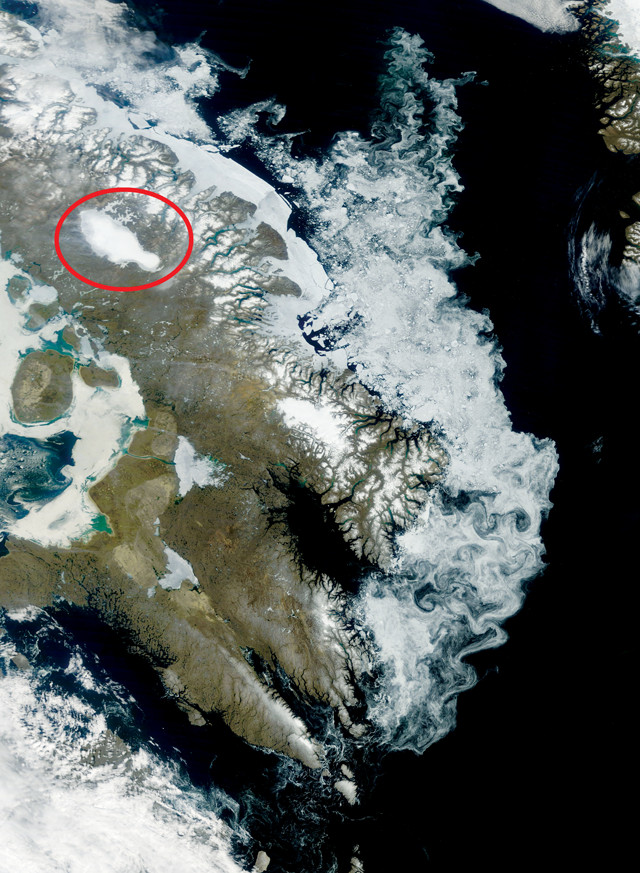
by Timothy Oleson Monday, June 19, 2017

The Barnes Ice Cap (circled in red) on Canada's Baffin Island is one of the few remnants of the massive Laurentide Ice Sheet, which covered much of North America during the last ice age. Credit: Jeff Schmaltz/NASA Earth Observatory.
From Antarctica to the Arctic; from polar caps, permafrost and glaciers to ocean-rafted sea ice; and from burly bears to cold-loving microbes, fascinating science is found in every nook and crevasse of Earth’s cryosphere, and new findings are announced often. Here are a few of the latest updates.
The Barnes Ice Cap, one of the last surviving remnants of the mighty Laurentide Ice Sheet, is likely to disappear within a few hundred years, according to a new study in Geophysical Research Letters. At its most recent peak, about 21,000 years ago, the Laurentide covered more than 10 million square kilometers, sprawling over most of Canada and reaching south into present-day Illinois and Pennsylvania. Today, the Barnes Ice Cap covers about 5,800 square kilometers on Canada’s Baffin Island, and although it remained stable for most of the past 2,000 years, warming Arctic temperatures have begun hastening its retreat in recent decades. Based on field studies and modeling, scientists found that the ice cap is melting at all elevations and that, at best, it’s likely to last another 500 years. Cosmogenic isotope evidence indicates the cap has previously shrunk to its current size only three times in the last 2.6 million years. But those episodes occurred during especially warm and/or long interglacial periods when Earth’s orientation and tilt exposed the Northern Hemisphere to more solar warming than it is currently receiving. “The fact that [the Barnes is] disappearing now says we’re really outside of what we’ve experienced in a 2.5-million-year interval, and we’re entering a new climate state,” said University of Colorado Boulder paleoclimatologist and study co-author Gifford H. Miller, in a statement.
Glacial ice is known to harbor significant amounts of long-stored organic carbon — roughly 6 billion metric tons worldwide — which escapes into glacial streams as ice melts and can be consumed by microbes locally or transported to the ocean. The full range of microbial contributions in such streams isn’t known, however, and has thus been overlooked in glacial carbon cycling models, noted Christine Foreman of Montana State University and her colleagues in a new study in Nature Geoscience. Foreman’s team studied the biogeochemistry of a stream flowing across the Cotton Glacier near the McMurdo Dry Valleys in Antarctica. They found that some of the organic carbon in the stream had indeed emerged from the ice after a long freeze or had been deposited from the atmosphere — mechanisms previously assumed to be the main suppliers of organic carbon to glacial streams. But, most of the carbon actually came from photosynthetic bacteria living in the stream, suggesting a “tight coupling” between the microbes producing the carbon and those consuming it. As glacial meltwater flows increase, these streams may thus play even bigger roles in the glacial carbon cycle.
In a new study in the Journal of Geophysical Research: Oceans, researchers have elucidated the forces steering Antarctic icebergs. Thomas Rackow of the Alfred Wegener Institute in Germany and colleagues modeled the movement and melting of nearly 7,000 icebergs, comparing the simulations to observations of large icebergs tracked by GPS. For relatively small icebergs less than 2 kilometers across, they found that wind is the main driver, quickly pushing these blocks into the open sea where they then break up and melt within a few years. Massive tabular ice sheets, however, are too large to be shoved by the wind as easily; instead, because of the slight tilt of the sea surface near Antarctica — sea level is generally higher closer to the coastline — and their own heft, they drift downslope and away from shore. But it’s a slow process, so these behemoths often stick close to the coast for years before they’re gradually pulled toward open water by the Antarctic Coastal Current or by pack ice. Even then, however, the Coriolis Effect bends their paths to the left, setting them on courses that partly parallel the Antarctic coastline rather than taking them due north. Some large icebergs last eight to 10 years and reach 60 degrees south latitude before finally disappearing. “The primary goal of our study was to understand in which region of the Southern Ocean the large icebergs melt, adding massive quantities of freshwater in the process. The fact that we have now also succeeded in unraveling the fundamental mechanisms [of their movement] so thoroughly is a wonderful extra bonus,” Rackow said in a statement.
© 2008-2021. All rights reserved. Any copying, redistribution or retransmission of any of the contents of this service without the expressed written permission of the American Geosciences Institute is expressly prohibited. Click here for all copyright requests.